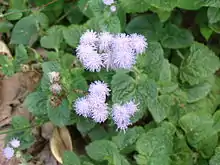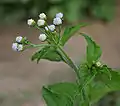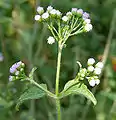Ageratum conyzoides
Ageratum conyzoides (billygoat-weed, chick weed, goatweed, whiteweed, mentrasto) is native to Tropical America, especially Brazil, and is an invasive weed in many other regions. It is an herb that is 0.5–1 m. high, with ovate leaves 2–6 cm long, and flowers are white to mauve.[2]
| Ageratum conyzoides | |
|---|---|
 | |
| Scientific classification | |
| Kingdom: | Plantae |
| Clade: | Tracheophytes |
| Clade: | Angiosperms |
| Clade: | Eudicots |
| Clade: | Asterids |
| Order: | Asterales |
| Family: | Asteraceae |
| Genus: | Ageratum |
| Species: | A. conyzoides |
| Binomial name | |
| Ageratum conyzoides | |
| Synonyms | |
|
Synonymy
| |
In Vietnamese, the plant is called cứt lợn (meaning "pig feces") due to its growth in dirty areas.[3]
Uses
As a medicinal plant, Ageratum conyzoides is widely used by many traditional cultures, against dysentery and diarrhea.[4] It is also an insecticide and nematicide.[5][4]
Toxicity
Ingesting A. conyzoides can cause liver lesions and tumors.[6][7] There was a mass poisoning incident in Ethiopia as a result of contamination of grain with A. conyzoides.[8] The plant contains the pyrrolizidine alkaloids lycopsamine and echinatine.
Weed risk
A. conyzoides is prone to becoming a rampant environmental weed when grown outside of its natural range. It is an invasive weed in Africa, Australia, Southeast Asia, Hawaii, and the USA.[9][10] It is considered a moderate weed of rice cultivation in Asia.[11]
References
- Tropicos search for Ageratum conyzoides
- "Ageratum conyzoides". NSW Flora Online.
- vi:Cứt lợn
- Panda, Sujogya Kumar; Luyten, Walter (2018). "Antiparasitic activity in Asteraceae with special attention to ethnobotanical use by the tribes of Odisha, India". Parasite. 25: 10. doi:10.1051/parasite/2018008. ISSN 1776-1042. PMC 5847338. PMID 29528842.

- Ming, L.C. (1999). "Ageratum conyzoides: A tropical source of medicinal and agricultural products". In Janick, J. (ed.). Perspectives on new crops and new uses. Alexandria VA: ASHS Press. pp. 469–473. ISBN 978-0961502706.
- Sani, Y.; Bahri, S. (1994). "Pathological changes in liver due to the toxicity of Ageratum conyzoides". Penyakit Hewan. 26 (48): 64–70. ISSN 0216-7662.
- Fu, P.P.; Yang, Y.C.; Xia, Q.; Chou, M.C.; Cui, Y.Y.; Lin G. (2002). "Pyrrolizidine alkaloids-tumorigenic components in Chinese herbal medicines and dietary supplements" (PDF). Journal of Food and Drug Analysis. 10 (4): 198–211. Archived from the original (PDF) on 2012-01-05.
- Wiedenfeld, H. (2011). "Plants containing pyrrolizidine alkaloids: toxicity and problems". Food Additives & Contaminants: Part A. 28 (3): 282–292. doi:10.1080/19440049.2010.541288. PMID 21360374. S2CID 23218347.
- Global Compendium of Weeds, Ageratum conyzoides (Asteraceae)
- Alan S. Weakley (April 2008). "Flora of the Carolinas, Virginia, and Georgia, and Surrounding Areas".
- Caton, B.P. (2004). A Practical Field Guide to Weeds of Rice in Asia. Int. Rice Res. Inst. pp. 16–17. ISBN 978-971-22-0191-2.
External links
- Plants For Future: Ageratum conyzoides
- Tropical Plant Database: Ageratum conyzoides
- Global Invasive Species Database: Ageratum conyzoides
- (in Portuguese) Ageratum conyzoides photos
- Ageratum conyzoides L. Medicinal Plant Images Database (School of Chinese Medicine, Hong Kong Baptist University) (in Chinese) (in English)
- Ageratum conyzoides in West African plants – A Photo Guide.
| Wikimedia Commons has media related to Ageratum conyzoides. |
Gallery




 From Kerala.
From Kerala.